
Headache Treatment Page Menu: 1 2 3 4 <<First
Treating Headaches During the Golden Age of Piracy, Page 4
Headache Remedies - External Medicines
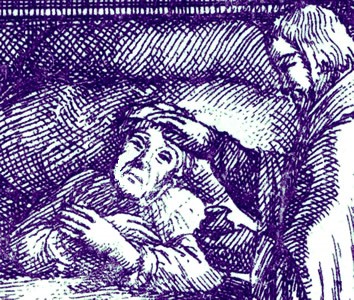
Medicating the Head - Extreme Unction (17th century)
There were a variety of external medicines applied to the head to cure headaches. Most of them fall into one of two categories: irritants that caused blistering or palliatives that soothed the pain.
French surgical author Ambroise Paré refers to several irritants, advising the use of "Vesicatorie [vesicatory - blistering medicines] and rubrifying [reddening - skin irritants] ointments, cataplasms [poultices - soft, moist materials], or plasters ...made of acrid medicines, which have the power to draw forth the superficies of the bodie such humors as lie deep, by exulcerating the skin and causing blisters."1 He later explains, "Wee use this kinde of medicine in long diseases, when wee cannot anie thing prevail with other remedies; especially in the head-ach, megrim, epilepsie, sciatica, gout, the bites and punctures of venomous creatures, pestilent carbuncles, and other inveterate and constumacious [difficult to cure] diseases."2
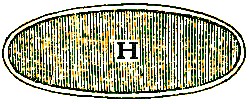
Blister Plaster, Cours d'Operations, p. 847 (1740)
French surgical teacher Pierre Dionis likewise advises vesicatory medicines for the 'Hemicranie', or hemicranis headaches. These are headaches concentrated on one side of the head. Purmann explains that such headaches "require the lively Agitation of the Fibres, and the violent drawing out of the Serosities"3. He tells his readers to "lay them on the hind part of the Neck, preparing the large Plaister H, which we lay betwixt the Shoulders."4
On the other side, we have the soothing palliatives. Several of apothecary John Quincy's palliative applications used vinegar as their base. He advised the use of Acetum Rosarum - or Vinegar of Roses - made with white wine vinegar. This was used "to ambrocate [apply to] the
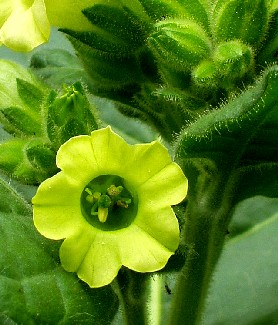
Photo: William Rafti - Tobacco Plant Leaves, Bud & Flower
Head and Temples in some kinds of the Head-Ach, in which it frequently does great service."5
Quincy also suggests using "Frontale Cephalicum, A Cephalick Frontal". (Cephalic means 'concerning the head.) This is made with Roses fried in vinegar or brandy sprinkled with nutmeg powder, white tumeric and henna. Frontale Cephalicum is applied "to the Forehead and Temples in violent hot beating Pains of the Head, and is to be refreshed with Vinegar as oftan as it grows dry, until it has answered its end."6
Noted period pharmacopoeia author Nicholas Culpeper was a fan of tobacco in treating headaches. He first says that tobacco leaves "warmed and applied to the Head are excellent good in inveterate Head-aches. I know not what better name to give it; Old Headaches [migraines and tension headaches], continual head-aches: take which we will] and Magarines [migraines]"7. He likewise advises the use of Unguentum Nicotiana (tobacco ointment), suggesting that "if your head ake, anoint your Temples with this, & you shall have ease."8
Culpeper

Apothecary Nicholas Culpeper
suggests several other external applications to assuage pain in the head. This includes nigella seeds boiled in oil, "the forehead [being] anointed with it, eases pains in the head"9. He counsels the use of another oil - Oil of Marjoram - noting that it "helps head ach, the forehead being rubbed with it."10 He also recommends verbena/vervain which, when "made into an Ointment, it is a sovereign Remedy for old Headaches"11.
Culpeper also advised the use of "Rhodie Rad. [or] Rose-root... stamped & applied to the head, it mitigates the pains thereof, being somewhat cool in quality."12 ('Cool' here refers to a facet of humor theory which is discussed in greater detail below.)
For 'violent' headaches, German military surgeon Matthias Gottfried Purmann suggests the application of a type of earth he calls 'tangt' "of a high Yellow Colour, almost resembling an Orange, of a piercing strong Aromatical Scent"13. To prepare this, Purmann says that the surgeon should "Scrape a little Quantity of this Earth into a Glass, then pour a Spoonful of Fountain or distilled Water upon it, and after it is well mix’d, rub your Temples and Forehead with it about the breadth of a Crown-piece twice a day, and it will take away the Pain, and give Ease immediately"14.
1,2 Ambroise Paré, The Workes of that Famous Chirurgion Ambrose Parey, p. 723; 3,4 Pierre Dionis, A course of chirurgical operations: demonstrated in the royal garden at Paris. 2nd ed., p. 477; 5 John Quincy, The Dispensatory of the Royal College of Physicians in London, p. 328; 6 Quincy, p. 608; 7 Nicholas Culpeper, Pharmacopœia Londinesis, p. 33; 8 Culpeper, p. 226; 9 Culpeper, p. 44; 10 Culpeper, p. 221; 11 Culpeper, p. 40; 12 Culpeper, p. 226; 13,14 Matthias Gottfried Purmann, Churgia Curiosa, p. 12
Headache Remedies - Internal Medicines
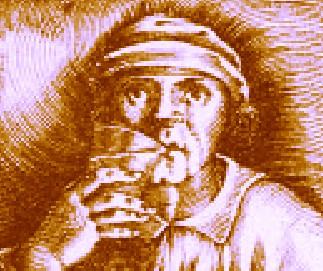
Artist: Jan van der Straet - Administering Medicine (1600)
The majority of medicines for headaches were given internally. English herbalist and apothecary Nicholas Culpeper explains the reason behind the use of such cephalic medicines in his renowned Pharmacopoeia.
The Brain is usually oppressed with moisture in such afflictions therefore give such Medicines as very greatly warm, cleanse, cut and dry: but withal let them be such as are appropriated to the head, such as Physicians say (by an hidden quality) strengthen the Brain. Again, if you consider the situation of the Brain, you shall find it placed in the highest part of the Body, therefore it is easily afflicted with hot vapours, this punisheth a man with watchings [sleeplessness] and head ach... in all [use] such Cephalicks [cephelic medicines] as cool the Brain.1
The hot and cold attributes of medicines were briefly mentioned in the previous section, but a greater explanation is needed to understand some of Culpeper's comments. Wet, warm, dry and cold are all humoral properties in medicine. Illnesses and medicines were each believed to have one or more of these four properties.
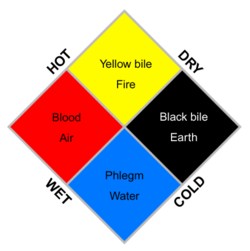
The Four Bodily Humors and Their Attributes
Referring again to the humor chart at left, we now focus on the properties seen on the outside of the diagram. You will notice that the four attributes are not directly attached to the individual diamonds in the center. The way these attributes are presented in many of the period apothecary works do not directly reference the bodily humors, although some of the more philosophical works do make such associations. (An excess of bile could be called a dry condition, for example.) Generally, however, the pharmacopoeias are not concerned with this link.
Instead, the pharmacopoeias suggest that the medicine required to treat an illness should contain the attribute that is opposite to that of the illness. So, for a dry illness a wet medicine would be recommended.
Nicholas Culpeper's pharmacopoeia often lists the humoral attribute associated with various simple medicines, rating the attribute's strength by degrees. Each attribute can have four degrees. Modern herbalist Matthew Wood gives an example of how these degrees were thought to work.
[H]eat in the first degree opens pores, heat in the second degree thins fluids, in the third degree it warms and in the fourth it burns. Furthermore, the second degree includes the first and fourth includes them all. Thus, the degrees are really more like what we would call grades. Like grades in a school one is either in one grade or another and the fourth grade builds on and includes the properties or lessons of the third, second, and first grades.2
While the attributes and their degrees are interesting, a complete explanation is arcane and unnecessary to understand the medicines presented here, so we will leave it at that and proceed to examine the internal medicines used for headaches.
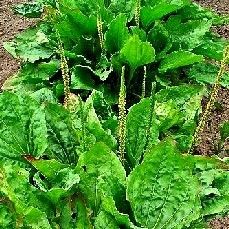
Photo: H. Zell - Plantago Major
Internal medicines run the gamut of types of medicines available to a period doctor. Culpeper recommends several herbs for 'pains in the head' including: plantago, which he says is "cold and dry"3; senna, which "heats in the second degree, and dryeth in the first, cleanseth, purgeth and digesteth [encourages the formation of new skin in wounds], it carries downwards both Choler, flegm and Melancholly"4; and thyme, which is "hot and dry in the third degree"5. It is interesting that all of these medicines are drying, suggesting headaches were considered a 'wet' illness. This agrees with Culpeper's original assertion that they are caused by an excess of moisture in the brain.
Culpeper also suggests a couple of seeds/nuts to be taken internally to "ease the pains of the Head" including nutmegs6 and anniseeds7, both of which he earmarks as being hot, with anniseeds also being dry. The heating quality of the seeds suggests that, in addition to having wet attributes, headaches also had cold ones.
A large number of liquids are recommended by period authors to treat maladies in the head. Culpeper advises the use of water of white Poppies8 and water of nightshade9 to combat headaches that are the result of too much heat (referring here to external heat resulting from "too long standing in the Sun"10 rather than humoral heat). Both of these concoctions have narcotic properties which would help ease (or at least distract the patient from noticing) pain. Culpeper warns that when making the nightshade, "Take heed you distil not the deadly Nightshade of the common [for] if you do, you may make mad work. Let such as have not wit enough to know them asunder [apart], have wit enough to let them both alone."11
Many
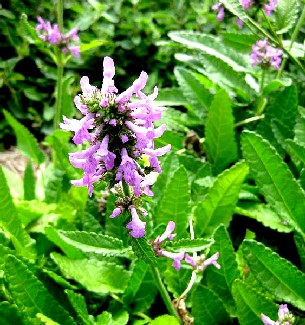
Image: Gardenology.org - Wood Betony
other, non-narcotic liquid remedies are suggested. Culpeper prescribes "distilled water of Water Lilly flowers" which has cooling properties to remedy "the head ach coming of hot Fevers pestilential and not pestilential"12. He also advises headache sufferers to try distilled waters of chamomile13, calamintha14, and lovage15. Oil of dill is likewise suggested to "asswage the pains of the Head"16.
Both Culpeper and fellow apothecary John Pechey advise the use of wood betony in liquids for headaches. Culpeper suggests the patient "may take a dram of it at a time in white Wine, or any other convenient Liquor proper against the Disease you are afflicted with."17 Pechey gives a different prescription, suggesting that "Counterfeit Tea, made of Sage, Betony and Ground-pine, sweetned, and drank hot is very good"18.
Culpeper and Pechey are also in agreement on the use of cowslip (primula veris) in liquid. Culpeper recommends water made from the flowers for both removing "pains in the head" and migraines.19 Pechey explains that "The Juice of the Leaves and Flowers mix'd with an equal quantity of Red-Cow's Milk cured an inveterate Head ach, when other Medicines would do no good."20
Pechey advises the headache sufferer to drink tea, specifically that harvested from the oriental camellia sinensis plant. "The Goodness of it is known by the fragrant smell of the Leaves: It smells somewhat like Hay, mix''d with a little Aromatick smell. 'Tis a green Colour, and tastes sweet, with a little bitter." He says this is particularly useful when the pain in the head "proceeds from Over-eating"21.
Photo: H. Zell - Citrullus Colocynthis
Two electuaries (sweetened pastes) and a lohoch (a sweetened, more syrupy sort of paste) were given orally to treat pains in the head in Culpeper's book.
The first electuary is another intricate creation called Hiera Diacolocynthidos. It includes a large variety of plants, including "Colocythis [citrullus colocynthis or bitter apple]; Agarick, Germander, white Horehound, Staechas... Opopanax Sagapen and Parsley seeds, round Birthwort roots, white Pepper... Spicknard, Cinnamon, Myrrh, Indian leaf or Mace, [and] Saffron."22 This is mixed with honey to create the sweet electuary. Culpeper specifically prescribes it for "the pain in the head called Kephalagia"23. It is not clear how Culpeper's cephalalgia headache differs from any other since cephalalgia simply refers to a headache in the modern medical parlance and Culpeper does not explain it further.
The second electuary is dideorum, another complex concoction which includes acorns, pine nuts and chickpea roots. A variety of spices are added to this mixture along with the honey needed to make the electuary. Culpeper explains that this would heat the brain against headaches caused by a cold humor, advising the patient to take half a dram "because of its heat."24 It "causeth an acute Wit, [and] easeth pains in the Head."25 Here again we see the reference to cold humoral attributes in headaches.Lohoch of Coleworts is the final sweetened oral agent that Culpeper suggests for headaches. It is made from colwort or cabbage and saffron, mixed with honey and sugar. This particular recipe is recommended for the "Head ach coming of drunkenness"26, and so might be of special interest to the pirates - provided it actually worked.
Culpeper also called for a pill and a lozenge as a way to treat headaches. The pill he recommends is Pilulæ Alaphangine which contains "Cinnamon, Cloves, Cardamoms the less, Nutmegs, Mace, Calamus, Aromaticus, Carpobalsamum, or Juniper berries, Squinanth, Wood of Aloes, yellow Sanders, red Roses
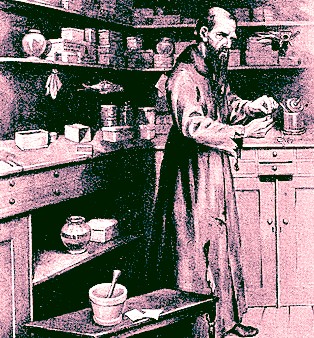
Artist: A.C. Wootton - Apothecary in His Workshop (17th c.)
dried, and Wormwood" which is bruised in distilled wine. Several spices are then added and the liquid is boiled off with the remainder being formed into a pill.
Culpeper recommended this pill for several illnesses including headaches. "I have often made Experience of it upon my own body; and always with good success in such occasions, and therefore give me leave to commend it unto my Countrymen for a very wholsome cleansing Medicine, strengthening, no wayes violent: one dram taken at night going to bed, will work gently next day"27.
Lozenges are roughly diamond-shaped pills made with sugar. (Today we associate them with cough drops.) The lozenge Culpeper advises is Saccharum Rosarum (Sugar of Roses). This is made with dried rose leaves which are combined with sugar in rose water and the juice of roses. Once the concoction is thoroughly mixed, Culpeper orders the reader to "put it upon marble, and make it into Lozenges according to art."28
The last ingested medicine is perhaps the most unusual to the modern ear - lapis ophites, a serpentine stone containing other minerals. Culpeper notes that "some of these stones have white lines in them: these are an admirable Remedy both for the Head ach and Lethargy: all of them being born about one, help the Head ach and biting of Serpents."29 He does not specify how the stone is to be prepared, although it is presumably ground up to be taken by mouth.
1 Nicholas Culpeper, Pharmacopœia Londinesis, p. 277; 2 Matthew Wood, Greek Herbal Medicine: The Four Qualities and the Four Degrees, gathered 12/14/14; 3 Culpeper, p. 34; 4 Culpeper, p. 37; 5 Culpeper, p. 39; 6 Culpeper, p. 42; 7 Culpeper, p. 43-4;8,9,10,11,12 Culpeper, p. 83; 13 Culpeper, p. 84; 14 Culpeper, p. 85; 15 Culpeper, p. 86; 16 Culpeper, p. 216; 17 Culpeper, p. 20-1; 18 John Pechey, The Compleat Herbal of Physical Plants, p. 20; 19 Culpeper, p. 83; 20 Pechey, p. 60; 21 Pechey, p. 337; 22,23 Culpeper, p. 175; 24 Culpeper, p. 159-60; 25 Culpeper, p. 160; 26 Culpeper, p. 138; 27 Culpeper, p. 181; 28 Culpeper, p. 142; 29 Culpeper, p. 80;
Headache Remedies - Internal Medicines: Inhalation
In addition to ingested medicines, a

Administering Medicinal Vapors, From a Compendium of Popular
Medicine and Surgery (1675)variety of inhaled preparations are suggested for their efficacy in treating headaches during the golden age of piracy.
John Quincy advised the use of a "Sacculus Anodynus, An Anodyne Bag" which "is to be dipped in hot Spirit of Wine, or any other convenient Liquor" creating a vapor that "will discuss [disperse] and dissipate what frequently causes the Tooth-ach, or Pain in the Ears, or any external Parts of the Head."1 The bag contains powdered camomile flowers, bayberries, lavender flowers, bay leaves, psycho-active henbane seeds [Hyoscyamus niger] and opium. It is easy to see why this might dissipate the pain of a headache.
Another vapor is suggested for headaches remaining after smoke inhalation by country physician Stephen Bradwell. He recommends a cooling 'perfume' such "as rose-water poured on a hot fire-shovell, or Camphor held to the parties nose; and the applying of a Rose-cake dipped in Veneger and Rose-water (or in a Veneger alone) to the forehead and temples."2
In a related vein, Culpeper recommends the smoke created by burning certain tree gums. "Gum Coopal [from the Daniellia tree] and Gum Anime [from the Hymenia courbaril tree of South America] are very like unto one another both in body and operation: the former is hard to come by, the last is not very easie, it stops defluxions from the head, if you perfume your cap with smoak of it, it helps the Head ach and Megrim [migraine], strengthens the Brain, & therefore the sinews."3
1 John Quincy, The Dispensatory of the Royal College of Physicians in London, p. 603; 2 Stephen Bradwell, Helps For Suddain Accidents Endangering Life, p. 108-9; 3 Nicholas Culpeper, Pharmacopœia Londinesis, p. 73
Migraine Remedies
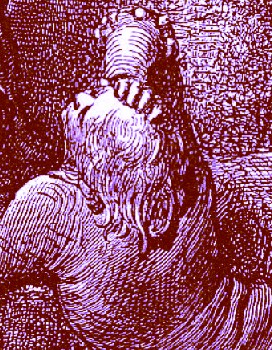
Artist: Gustav Dore - From The Inferno, Canto 33 (1857)
We have already seen a couple of remedies that were suggested for migraines when examining cures for other headaches. These include the application of tobacco leaves1, inhalation of the smoke of burning Gum Coopal and Gum Anime2 and cowslip given in liquids3.
Sea surgeon John Woodall adds another medicine to these: Mithridate of Damocrates. He explains that it "is in quallity and vertue like to Treakell [London treacle], but more hotter and forcible"4. Again we find a reference to the cold attribute of headaches. The receipt for this concoction is complex, containing at least 54 ingredients according to Culpeper.5 Rather than list them all here, these ingredients and their quantities can be found in the article on Woodall's Medicine Chest.
In addition to medicines, each of the humoral treatments used for regular headaches were also recommended to treat migraines. Ambroise Paré advises the use of a blistering plaster made with cantharides (Spanish fly) for migraines.6 Although he does not use the word migraine, Matthias Gottfried Purmann talks about using a fontanel for a woman who was "continually troubled with an excessive Pain both in her Head and Teeth".7
Arabic surgeon Albucasis counseled that "Venesection of the two veins behind the ears" would give relief for those suffering with a migraine.8 He also advised the use of wet cupping on the sides of the neck to treat the problem.9 Wet cupping is performed by making several small incisions in the skin and then placing the evacuated cupping glass over them, which draws the blood out. He warns his reader "to bid the cupper not to scarify [cut the incisions] very deeply lest he cut an artery and cause haemorrhage."10
Paré also recommended "opening an arteries in the temples" when "the caus of the pain proceed from hot, thin and vaporous blood, which will yield to no medicines"11. He goes on to detail
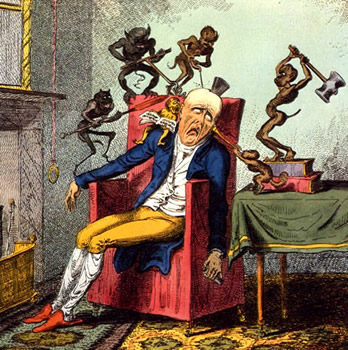
Artist: George Cruikshank - The Head-Ache (1819)
the procedure in a case study where he treated a prince "troubled with this grievous Megrim". The royal physicians had tried "blood-letting, cupping, bathes, frictions, diet" and medicines without success.12
I beeing called, said, that there was onely hope one way to recover his health, which was to open the arterie of the temple in the same side that the pain was; for I thought it probably, that the caus of his pain was not contained in the veins, but in the arteries, in which case by the testimonie of the antients, there was nothing better then the opening or bleeding of an arterie, whereof I have made trial upon my self to my great good.
When as the Physicians had approoved of this my advice, I presently betake my self to the work, and choos out the arterie in the pained temple, which was both the more swoln and beat more vehemently then the rest. I open[ed] this, as wee use to do in the bleeding of a vein, with one incision, and take more than two sawcers of blood flying out with great violence, and leaping; the pain presently ceased, neither did it ever molest him again. Yet this opening of an Arterie is suspected by mainie, for that it is troublesom to stay the gushing forth blood, and cicatrize [heal] the place, by reason of the densitie, hardness and continual pulsation of the arterie13
Opening the arteries of the temple sounds a bit drastic to most of us, although anyone who has ever had a vehement, long-lasting migraine might be willing to consider it. (Note: I do not recommend this as I seriously doubt it would work, Paré's experience notwithstanding.)
1 Nicholas Culpeper, Pharmacopœia Londinesis, p. 226; 2 Culpeper, p. 73; 3 Culpeper, p. 83; 4 John Woodall, the surgions mate, p. 84; 5 Culpeper, p. 163-4; 6 Ambroise Paré, The Workes of that Famous Chirurgion Ambrose Parey, p. 723; ,7 Purmann, p. 23; 8 M.S. Spink, and G.L. Lewis, Albucasis On Surgery and Instruments; A Definitive Edition of the Arabic Text with English Translation and Commentary, p. 626; 9,10 Spink and Lewis, p. 658-60; ,11,12 Paré, p. 401; 13 Paré, p. 401-2

